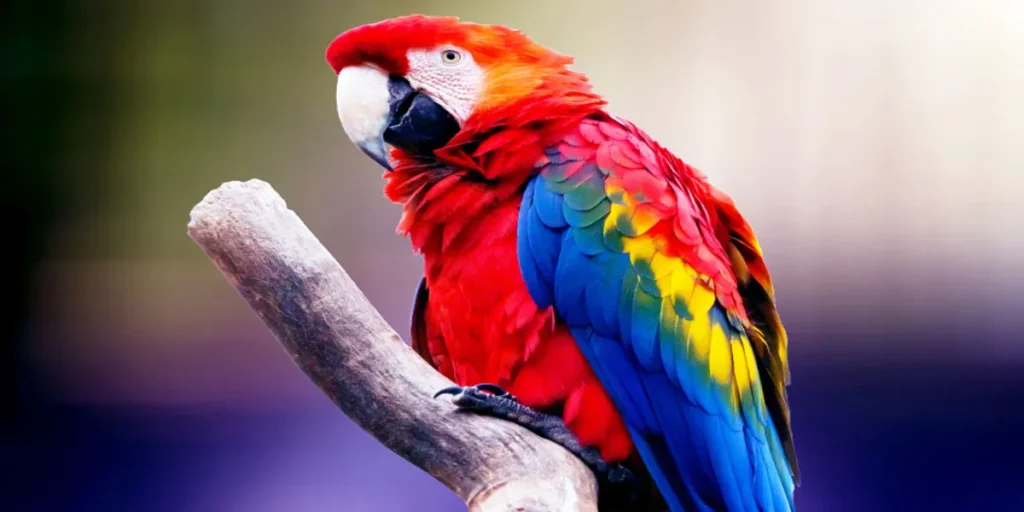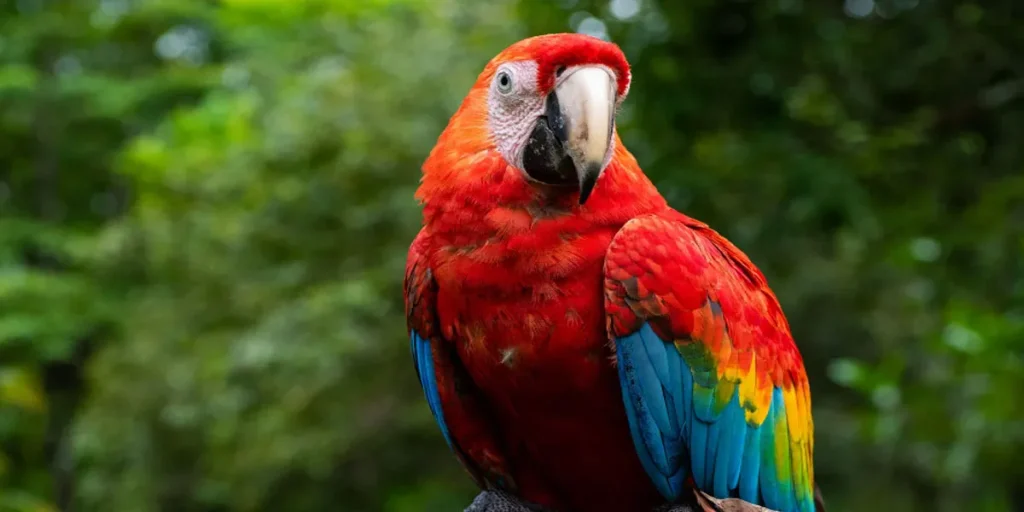A parrot’s weight varies widely, ranging from about 10 grams to over 4 kilograms. The species determines the size and weight.
Parrots captivate us with their vivid colors and remarkable ability to mimic human speech, making them one of the most popular and enchanting pets.
Across the globe, these intelligent birds come in various species, each with distinct characteristics, including their weight.
Whether you’re considering a tiny Budgerigar or a majestic Macaw, understanding the weight range is crucial for providing proper nutrition and care.
As pet enthusiasts delve into the world of aviculture, the importance of knowing these details becomes clear to ensure the health and happiness of these feathered companions.
With careful attention to diet and living conditions, a parrot can become a cherished member of any household, bringing joy with their playful antics and social nature.
The Average Weight Of Parrots

Light as a Feather: The Average Weight of Parrots ignites curiosity in the hearts of bird enthusiasts.
Parrots, known for their vibrant colors and intelligence, vary greatly in weight. Understanding their average weight helps gauge health and dietary needs essential for their longevity.
From Tiny To Tremendous: Spectrum Of Parrot Sizes
Parrots come in a dazzling array of sizes, each with a weight range that mirrors its physical dimension.
Small parakeets tip the scales at just ounces, while hefty macaws can reach weights comparable to a domestic cat.
This size spectrum highlights nature’s diversity within the parrot family.
Weights Of Common Parrots
Let’s explore the weights of popular parrot species:
| Parrot Species | Average Weight |
|---|---|
| Budgerigar | 1.1 – 1.4 ounces (30 – 40g) |
| Cockatiel | 2.8 – 3.5 ounces (80 – 100g) |
| Conure | 2.5 – 3.5 ounces (70 – 100g) |
| African Grey | 14 – 18 ounces (400 – 500g) |
| Amazon Parrot | 12.3 – 23.2 ounces (350 – 660g) |
| Macaw | 2 – 3.75 pounds (900 – 1700g) |
- Tiny parakeets enchant with their light build;
- Cockatiels and Conures offer a mid-range option;
- African Greys present a heavier choice for parrot lovers;
- Amazon Parrots boast a robust body;
- Giant Macaws showcase the upper echelons of parrot weights.
Factors Influencing A Parrot’s Weight

Curious about what tilts the scales when it comes to a parrot’s weight? It’s not just a simple number.
A parrot’s weight can tell a story about its health, lifestyle, and well-being. Multiple factors influence these vibrant birds’ mass.
Let’s explore how age, diet, and activity sculpt our feathered friends’ figures.
Age And Growth Stages
Like us, parrots grow and change as they age. Baby parrots, known as chicks, hatch at a light weight. They then experience a rapid growth spurt.
An adult parrot’s weight reflects their maturity. As seniors, they may lose weight due to natural aging processes.
The table below shows average weights by age for a common parrot species:
| Age Stage | Average Weight |
|---|---|
| Chick | 10-20 grams |
| Adolescent | 30-100 grams |
| Adult | 100-200 grams |
| Senior | 90-180 grams |
Diet And Nutrition
Parrots need a balanced diet to maintain a healthy weight. Foods rich in vitamins and minerals lead to ideal growth.
Inadequate nutrition can result in weight loss or obesity. Feeding habits impact their scales significantly. Below is a list of foods contributing to a parrot’s well-rounded diet:
- Fruits: Apples, bananas, berries
- Vegetables: Carrots, peas, leafy greens
- Grains: Brown rice, quinoa
- Proteins: Nuts, cooked beans
Exercise And Activity Levels
Parrots are active creatures needing daily exercise to stay fit. A sedentary lifestyle can lead to weight issues.
Flying and playing contribute to a healthy metabolism. Parrots that engage in regular physical activity generally have a healthier weight range. Here’s how you can keep your parrot active:
- Provide ample space for flying
- Include toys for mental stimulation
- Schedule daily playtime
Measuring A Bird’s Mass
Measuring a Bird’s Mass: Techniques and Tools is vital for parrot owners. It helps track the health of these colorful companions.
Using the right tools ensures accuracy and safety for the birds. Knowing a parrot’s weight is essential for proper feeding and detecting any possible health issues early on.
Scales For Avian Friends
To measure a parrot’s weight, specialized avian scales are the best choice. These scales are designed to accommodate the bird’s unique needs.
They often feature a perch rather than a flat scale top found in other types.
- Digital kitchen scales with a perch attachment
- Avian veterinary scales for more precise measurements
- Handheld scales for small birds
Choosing the right scale depends on the size and breed of your feathered friend. Consistency is key in weight tracking.
| Type of Scale | Suitable for Bird Size |
|---|---|
| Digital Kitchen Scale | Small to Medium Parrots |
| Avian Veterinary Scale | All Sizes |
| Handheld Scale | Small Birds Only |
Accuracy Matters: Ensuring Reliable Weights
To get reliable weights for your parrot, follow these tips:
- Weigh your bird at the same time each day.
- Ensure the parrot is calm during the process.
- Zero the scale before use for precise readings.
- Record the weight immediately to monitor changes.
Daily weighing is recommended for sick birds. Weekly checks suffice for healthy parrots.
Monitoring Weight For Wellness
Keeping your feathered friend healthy means keeping an eye on their weight. Just like in humans, weight is a good health indicator in parrots.
Regularly checking it can reveal hidden health issues early on. It’s a simple step that can help maintain the well-being of your colorful companion.
Weight Fluctuations As Health Indicators
Parrots have an optimal weight range necessary for good health. A well-balanced diet and regular activity keep them within this range.
Slight weight changes are normal and can happen due to diet variety, exercise, and stress. Consistently tracking weight is crucial.
It enables owners to spot unusual changes that might indicate a problem.
- Weight gain might signal overfeeding or lack of exercise.
- Weight loss could point to malnutrition or illness.
A simple way to monitor your parrot’s weight is using a digital scale. Regular weigh-ins should be part of their routine. Record their weight to track trends over time.
Breeds vary in size, so consult a vet for the ideal weight range for your specific parrot.
When To Be Concerned?
Sudden weight changes are a red flag. A loss can be especially troubling if it happens rapidly. If your parrot loses 10% of their body weight, this is critical.
They need a vet immediately. Unexplained weight gain could also be worrisome. It may signal an underlying issue.
Keep these points in mind:
| Weight Change | Action |
|---|---|
| Minor fluctuations | Observe and record |
| Steady or sudden loss | Contact your vet |
| Steady or sudden gain | Assess diet/activity, consult vet |
Note any changes in appetite or behavior along with weight change. Combine this with regular health checks.
This proactive approach ensures your parrot stays happy, healthy, and vibrant. Schedule regular veterinary check-ups.
This will help catch issues not visible through weight monitoring alone.
The Surprising Heft Of Parrots
Parrots dazzle us with their vibrant colors and witty mimicry. But there’s something unexpected about these avian companions: their weight.
Though they appear light and airy, holding a parrot reveals a different story. Let’s explore the surprising heft in these feathered friends and understand just why parrots are heavier than they look.
Dense Feathers
Parrots are often associated with a lush plumage that seems to add little to their mass. Yet, this is misleading.
- Dense feathers act as insulation.
- Feathers
contribute to overall weight. - Plumage can
be deceptively heavy.
Powerful Muscles
Another element contributing to a parrot’s weight is their muscular build. Parrots need strong muscles for flight.
| Pectoral Muscles | Percent of Body Weight |
|---|---|
| Flying Birds | Up to 25% |
| Parrots | about 20% |
Why Parrots Weigh More Than Expected?
The heft of a parrot comes from dense feathers and muscle mass.
- Avian bone structure is rigid.
- Feathers and muscles add up.
- Parrots have larger organs relative to body size.
Though sizes vary, parrots can weigh from 10 grams to 1.5 kilograms. Smaller species like budgies are on the lighter end, while larger parrots like macaws bring the scales higher.
Comparing Parrot Weights
Parrots dazzle us with their vivid colors and charming personalities. But their weights vary as much as their hues and traits.
From tiny to massive, parrot breeds come in a wide range of sizes. This diversity impacts dietary needs, habitat choices, and care requirements.
Let’s explore the various weights across different parrot species!
Miniature Marvels: The Lightest Parrot Breeds
Some parrot breeds seem almost weightless. These ‘Miniature Marvels’ balance on our fingertips.
The lightest breeds, such as Budgerigars and Lovebirds, tip the scales at a mere 30 to 60 grams.
- Budgerigar: 25-40g
- Lovebird: 40-60g
- Parrotlet: 20-30g
Majestic Macaws: At The Top Of The Scale
In stark contrast stand the ‘Majestic Macaws’, the giants of the parrot world. These large parrots weigh much more.
The Hyacinth Macaw, for instance, can weigh up to 1,250 to 1,700 grams. Their substantial mass reflects their powerful beaks and large wingspans.
| Macaw Species | Average Weight |
|---|---|
| Hyacinth Macaw | 1,250-1,700g |
| Green-winged Macaw | 1,000-1,400g |
| Blue and Gold Macaw | 900-1,200g |
FAQ About the Weight of A Parrot
What Is The Average Weight Of A Parrot?
Parrots come in various sizes, so their weights vary. Small parrots like budgies average around 30 to 40 grams.
Medium-sized parrots like cockatiels weigh around 75 to 125 grams.
Large parrots, such as macaws, can weigh from 900 grams to 1,500 grams, depending on the species.
How Much Does An African Grey Parrot Weigh?
African Grey parrots, known for their intelligence, usually weigh between 400 to 600 grams.
This weight range is typical for healthy adults. Their exact weight can vary based on diet, age, and individual health factors.
Can Parrot Weight Indicate Health Status?
Yes, a parrot’s weight is a good indicator of its health. Sudden weight gain or loss can signal potential health issues.
Regular weigh-ins are important for monitoring a parrot’s health and should be part of routine care.
What Factors Affect A Parrot’s Weight?
Several factors can affect a parrot’s weight, including species, diet, age, and activity level.
Metabolic rates and overall health also play roles. A balanced diet and regular exercise are key for maintaining a healthy weight.
Conclusion
Understanding a parrot’s weight is crucial for its health and wellbeing. Sizes vary, from tiny budgies to majestic macaws.
Regular weigh-ins are a must. For responsible parrot care, stay informed and consult a vet. Cherish your feathered friend’s colorful presence, at any weight!
Resources:
https://www.betterhealth.vic.gov.au/health/conditionsandtreatments/psittacosis-parrot-fever
https://nre.tas.gov.au/conservation/threatened-species-and-communities/lists-of-threatened-species/threatened-species-vertebrates/orange-bellied-parrot
